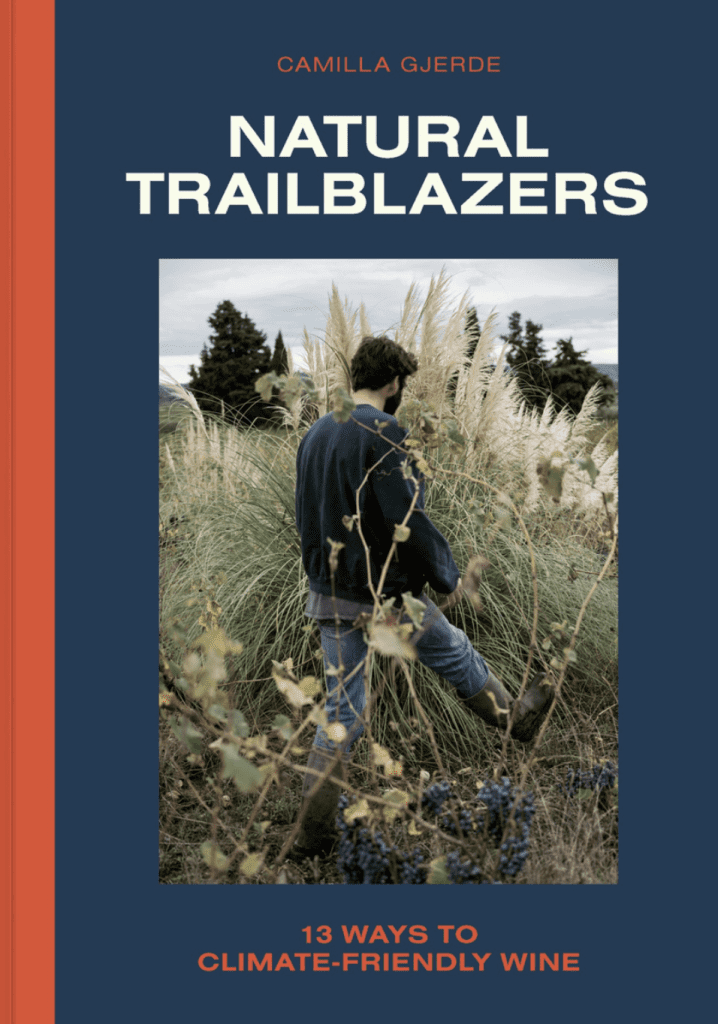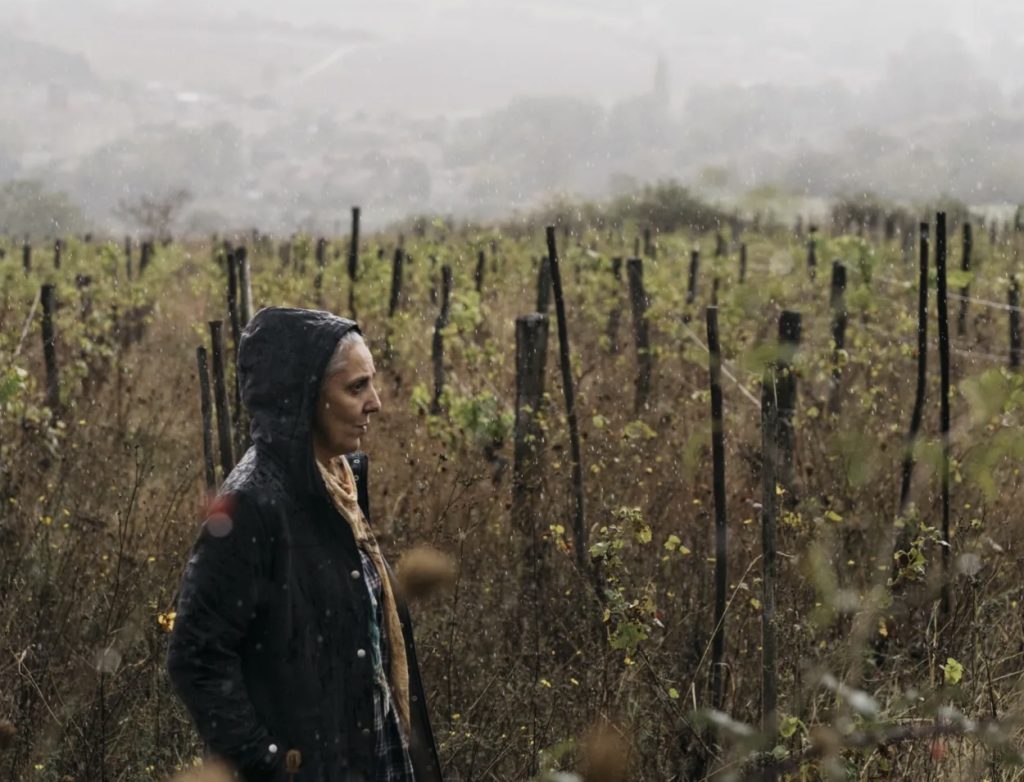Valerie Kathawala is inspired by Natural Trailblazers, a recently-published book that profiles European winegrowers who are pioneering ways of reducing wine’s environmental impact. She argues that there are implicit lessons about how we wine journalists might rethink approaches to our own work.
‘What guides me is the idea of less,’ says Alsatian winegrower Yannick Meckert. “Less, less, less.”
Meckert and a dozen other pioneers of the complicated effort to reduce wine’s environmental impact are the subjects of an excellent new book by Swedish author Camilla Gjerde. In Natural Trailblazers: 13 Ways to Climate-Friendly Wine (October 2024, Now What Publishing), she profiles small-scale natural wine producers, importers and distributors who feel called to question, experiment, and take risks in the name of preserving heritage and future — one fraction of a hectare, one un-used light bulb, one sail-borne bottle at a time.
Her book is a group portrait of 13 individuals who are not a group, but whose objectives connect them in a loose ecosystem, a guild. Gjerde illustrates the essence of each in vivid, well-chosen strokes. Her words are tight and punchy. We feel a fierce wind in the Auvergne that threatens to send her reporting off course, the electricity of a Valais vineyard in full spring flourish. We sense the painful choices a grower has to make between financial viability and core beliefs. There are scattered tasting notes, but they are emotional, not technical: ‘It is a beautifully pure wine with loads of raspberries and a hint of bitterness, making me happy, my first and foremost criterion of a good wine,’ she writes of Thierry Hesnault’s pét-nat, made from old-vine hybrids in the Loire. The text is framed by handsome design and packed with moody, evocative photos by Cecilia Magnusson.
Although a few of the trailblazers profiled will be familiar to wine world watchers, most are still little known. As yet, their efforts have not registered much in the larger wine narrative. ‘To inspire change,’ Gjerde writes, ‘their stories need to be told.’ If, after reading their stories, you don’t feel both outraged by the lack of societal, market and systemic support for these visionaries and impelled to act in your own way, go back and read the book again. We wine journalists, in particular, have something to learn here.
 Gjerde holds a doctorate in political science. Before she turned to wine, she worked in government, where her job was to train civil servants in integrity questions and ethical dilemmas. Integrity and ethics give this book a quiet and impressive cohesion. Gjerde conducted all but one leg of her research and reporting by rail and bicycle: 15,445 km / 9,597 miles on trains, 185 km /115 miles by bike. She chose an ecologically sensitive Danish press to print the book, on cradle-to-cradle certified paper. She informs readers of the the environmental cost of producing each physical volume: 0.9kg/1.98 lbs of CO₂e (carbon dioxide-equivalent) emissions — roughly the same as making three glasses of wine.
Gjerde holds a doctorate in political science. Before she turned to wine, she worked in government, where her job was to train civil servants in integrity questions and ethical dilemmas. Integrity and ethics give this book a quiet and impressive cohesion. Gjerde conducted all but one leg of her research and reporting by rail and bicycle: 15,445 km / 9,597 miles on trains, 185 km /115 miles by bike. She chose an ecologically sensitive Danish press to print the book, on cradle-to-cradle certified paper. She informs readers of the the environmental cost of producing each physical volume: 0.9kg/1.98 lbs of CO₂e (carbon dioxide-equivalent) emissions — roughly the same as making three glasses of wine.
By building her methods into the narrative, even holding the book in our own hands, Gjerde compels us to consider the environmental impact of our own ways of working and living. Her art is to make this approach feel within grasp: more challenging, yes, but also far more meaningful, and quite possibly a lot more fun.
‘There are many ways to reduce wines’ carbon emissions, in the vineyard, the cellar and en route. The important thing is to do what matters most,’ Gjerde notes. The book is divided into three sections covering each of these areas. We the readers get to decide which matters most.
Is it most important to turn a vine monoculture into a resilient ecosystem? Grower Christine Pieroth experiments with agroforestry in the Nahe, Germany, where organic viticulture is off to a slow start. Undaunted, she’s taken over some tiny plots and is rethinking the ecological balance of each, hoping to create vineyards that can, as Gjerde writes, ‘cope with the new climate’ and to make habitats ‘where there is room for more than just grapes.’
Is it most important to create a market for the grapes of long-time organic growers? Auvergne, France-based vigneronne Catherine Dumora believes in preservation — of her own strength, regional biodiversity, and social connections, all expressed in wines that help keep old-vine parcels and those who tend them vibrant.
Is it most important to innovate new techniques for carbon capture? Hans-Peter and Romaine Schmidt in Valais, Switzerland, are pioneers in making and using biochar (burning organic material such as vine clippings in a special kiln without oxygen) to improve soil health and carbon sequestration capacity.
Is it most important to adopt cans, kegs, or bagnums to minimize waste and lighten the carbon load of wine transport? Éric Texier, near Lyons, and Paolo Bertain, in Puglia, argue yes.
Is it most important to focus on long-range delivery — by rail or sail — or on the last mile of a wine’s journey to a drinker’s glass? Danish importer and distributor Christopher Melin and his crew believe using a fleet of e-cargo bikes to bring 90% of their wines to customers doesn’t just bring fresh air and a clean conscience. ‘You get closer to your clients,’ he says. ‘One of the good things about bikes is that it’s so easy to just stop. I almost always meet people I know when I’m out on the streets. Or I think, “Hey, I haven’t heard anything from that restaurant in a long time,” and I just pop in to check on them. We’ve definitely got more sales from being on our bikes.’
Ecological equals economical
Ecological is usually economical. A German winegrower said this to me once. I turned his words over and over as I read Natural Trailblazers. It costs much more to ship wine under sail than by diesel truck. But that is an externalized cost, only accounting for the immediate, visible expenses, not the long- and very long-term costs of ecological balance and species survival.
There is a transdisciplinary field known as ecological economics that attempts a more integrated look at ‘humans embedded in their ecological life-support system, not separate from the environment’ as Professor Robert Costanza, who specializes in this field, writes. His words feel like an excellent summation of Gjerde’s trailblazers. Sustainable scale, fair distribution, and efficient allocation — ‘all three of these contribute to human well-being and sustainability,’ says Costanza. We pay the cost of not investing in our planet’s future with every failed harvest, every superstorm, every pandemic.
Moral coherence
‘Moral coherence’ is regrettably absent from most human thinking. But to these 13 figures, it’s imperative. Yannick Meckert, a grower in Alsace, notes that when he was developing his interest in natural wine more than 15 years ago, he flew around the world, thinking he could save it through wine. In 2022, he stopped flying. ‘A trip to New York and back is the equivalent of one French person’s carbon footprint for six months,’ he explains.
Natural winemakers grapple with a paradox: their energy and attention are hyperlocal, yet they are more dependent on global training, peers, and markets than any previous generation. Because acceptance of natural wine styles at home tends to lag foreign enthusiasm, natural producers are fundamentally reliant on carbon-costly exports for economic survival.
That doesn’t sit right with Lyon vigneronne Géraldine Dubois. She e-bikes her wines to customers in Lyon, then returns to collect the empties, which she later washes herself. ‘In the vineyard,’ she notes of her colleagues, ‘they start working with a horse, increasing biodiversity, and introducing fungus-resistant grape varieties; and in the cellar, they make wine without additives and work manually as far as possible. And then in the last phase, they send their bottles to the other side of the planet. I don’t criticise others, but I want to show that there’s another way of doing things.’
A running theme in the book is the abundance of other ways of doing things and the shortage of individuals, businesses or governments willing to put them into practice. Éric Texier is eager to sell his wines in reusable plastic kegs or the 1.5-liter pouches known as bagnums, but says only 5% of his customers accept this packaging. ‘Most drinkers and importers don’t care about the environmental aspect,’ Texier tells Gjerde. Ida Sundqvist wants 100% of the wines she imports to Sweden to arrive by rail, but higher costs mean only 23% do. The problem is cooperation and scale. ‘Others are not willing to pay more for a few days of extra shipping – and Ida’s company is too small to fill a train wagon by itself,’ Gjerde writes.
Natural Trailblazers arrives at a pivotal moment. Each day, climate events dictate more of the subjects we wine journalists cover. Moreover, as the wine industry groans and shudders through contraction and realignment, now is the time to re-examine some of the most basic practices of how wine is grown, made, and sold — and how we tell the stories of those who are doing so.
Working with a lighter footprint
Without preaching or imploring, Gjerde’s account urges us to stretch our imaginations about how we can work with a lighter footprint. This should prompt us as journalists to rethink a great number of things, starting with which beats we cover and how we cover them. Mine is Germany and Austria — some 4,000 miles from my home in New York. Influenced in part by Gjerde’s first book (We Don’t Want Any Crap in Our Wine, 2021) and the environmental work of Professor Kimberly Nicholas, I have thought long and hard about quitting my transatlantic habit. I’m still working out my own complicated answer, but it’s some combination of evaluating a number of questions. Which stories do we choose to tell? Should we opt out of flying? Batch our plane-dependent travel? Plan our visits for seasons when travel by bike makes sense and share cars or go by rail when not? Advocate for more environmentally responsible press trips? Abandon them altogether? Which sacrifices of comfort or convenience are we willing to make for the sake of survival?
Gjerde never glosses over the thornier compromises or contradictions while searching for her answers. A grower eschews the conveniences of electricity or running water in his cellar, but puffs on a known pollutant. Gjerde lets the irony stand, unremarked. Human nature is, of course, the reason for the ecological predicament we’re all in.

